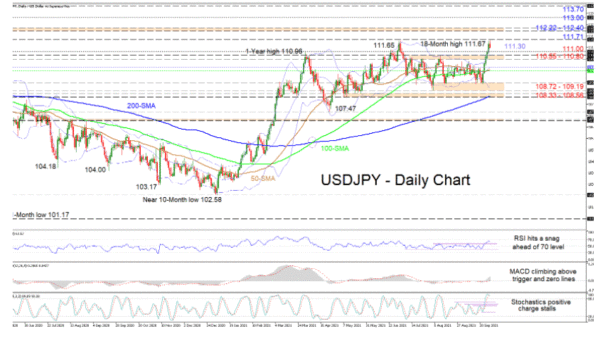USDJPY is confronting the March 2020 rally high of 111.71 for a second time in nearly three months after its recent bullish propulsion from around the 109.00 handle. The 200-day simple moving average (SMA) is defending the medium-term positive structure, while the marginal upturn in the 50- and 100-period SMAs, is indicating the recent intensity in positive price action.
The short-term oscillators are reflecting the battle buyers are encountering in pushing above the crucial 111.71 resistance boundary. Despite the MACD strengthening over its red trigger and zero lines, the RSI is struggling to extend higher into overbought territory. Moreover, above the 80 level, the positive charge in the stochastic oscillator has weakened, though the %K line has yet to confirm sellers have the upper hand.
If buyers retake the reins and manage to conquer the tough 111.71 barricade, they may jump for the 112.22-112.40 border, formed between the February 2020 and April 2019 highs respectively. Successfully breaking above this resistance belt could then boost buyers’ confidence to propel for the 113.00 handle and the vital 113.70 December 2018 high.
Otherwise, if the 111.71 obstacle stands firm and sellers drive the price beneath the upper Bollinger band at 111.30, downside limitations could commence from the 111.00 hurdle ahead of the support region of 110.55-110.80, moulded by the inside swing highs. Moving lower, the area between the mid-Bollinger band at 110.07 and the 100-day SMA at 109.87 may help the pair find its feet. Yet, if the drop in price persists, the reinforced support base of 108.72-109.19 could attempt to terminate additional deterioration in the pair. However, should the price retracement prevail beneath the 108.72 trough, the adjacent support band of 108.33-108.56 could come under attack.
Summarizing, USDJPY is exhibiting a slight weakness in upward impetus however, its neutral-to-bullish tone remains intact above the 110.55-110.80 barrier.














